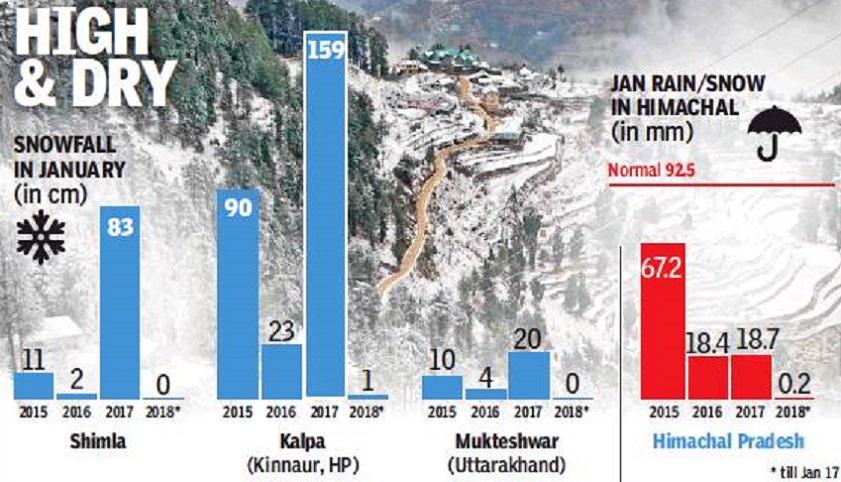January weather in India
(→2018: 'Superfog') |
(→HP, Uttarakhand, 2018) |
||
| Line 42: | Line 42: | ||
Mallika Virde, environmental activist and sarpanch of a van panchayat near Munsiyari, a town at the base of the Panchachuli peaks in Pithoragarh district, said the town received just one snow spell this winter. | Mallika Virde, environmental activist and sarpanch of a van panchayat near Munsiyari, a town at the base of the Panchachuli peaks in Pithoragarh district, said the town received just one snow spell this winter. | ||
| + | == HP: Jan 2018, 2019== | ||
| + | [[File: Snowfall in HP in Jan 2018 and till 19 Jan 2019.jpg| Snowfall in HP in Jan 2018 and till 19 Jan 2019 <br/> From [https://epaper.timesgroup.com/Olive/ODN/TimesOfIndia/shared/ShowArticle.aspx?doc=TOIDEL%2F2019%2F01%2F20&entity=Ar00501&sk=79A73F11&mode=text '' The Times of India ''] |frame|500px]] | ||
| + | See graphic, ' Snowfall in HP in Jan 2018 and till 19 Jan 2019 ' | ||
=1st January= | =1st January= | ||
Revision as of 10:47, 20 January 2019
This is a collection of articles mainly from the Delhi- based press. |
This page is under construction
January as a whole
Snowfall
HP and Uttarakhand, 2015-18
See graphic, ' January snowfall in HP and Uttarakhand, 2015-January 17, 2018 '
HP, Uttarakhand, 2018
Apple Crop, Water Supply Could Be Hit
2018-01-18: The peak winter period is almost over in north India and no major hill station in Himachal Pradesh and Uttarakhand has yet received a single spell of snow. January has been almost totally dry across the region so far
Uttarakhand has a 100% rain deficit in January so far, while in Himachal Pradesh it is more than 99%. The northern plains too have had no rain in January, which is a major reason for the mild winter so far.
In fact, just one major wet spell has hit north India this winter. That came around December11-12, when most parts of the plains got rain while the higher reaches of the Himalayas had snowfall. For the rest of December, rain/snow remained confined to Jammu and Kashmir and a few places in the higher Himalayas.
This winter, the position of western disturbances (WDs) coming into north India has been more northerly than usual. These have mainly affected northern J&K, leaving almost no impact on the rest of the region. Most of the WDs have also been feeble,” said Kuldeep Srivastava, head of the IMD’s Regional Weather Forecasting Centre.
WDs, which are waves of cold, moist winds coming in from southern Europe and west Asia, are the only source of wet weather in winter across north India. WDs also regulate the weather during the season, bringing in cold spells in their wake.
“Shimla hasn’t recorded any snow this winter. In January, it hasn’t even rained so far. If the dry weather continues through the month, it would be the first time in 11 years that Himachal’s capital will go snowless in January,” said Manmohan Singh, head of Shimla’s Met office.
The official said there was growing concern over the impact of the dry weather on the state’s apple production, as the minimum number of chilling hours required for a good output has not been met so far. “Low snowfall accelerates melting of glaciers. In low snowfall years, Himalayan rivers have less water in summer which impacts irrigation in downstream states such as Punjab and Haryana while hitting hydro-power production,” Singh said.
“There has been no snow activity yet in Uttarakhand this month due to absence of any strong WD,” said Bikram Singh, director of the regional Met centre in Dehradun. Mukteshwar, where the sole IMD snow gauge in the state is located, is yet to record any activity this winter.
Mallika Virde, environmental activist and sarpanch of a van panchayat near Munsiyari, a town at the base of the Panchachuli peaks in Pithoragarh district, said the town received just one snow spell this winter.
HP: Jan 2018, 2019
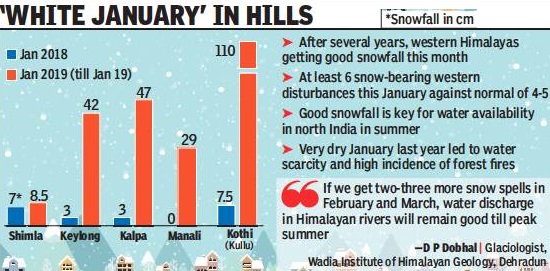
From The Times of India
See graphic, ' Snowfall in HP in Jan 2018 and till 19 Jan 2019 '
1st January
Munnar/ minus 4°C, 2009
Chenduvarai near Munnar recorded a low of -4 degree Celsius on January 1, 2009, the lowest in memory.
2nd January
Jammu & Kashmir
2018
Jammu Minimum temperature was 6.0 degree C
Kargil minus 6.1 degrees Celsius
Leh minus 14.7 degrees
3rd January
Central Pakistan to Tripura
2018: 'Superfog'
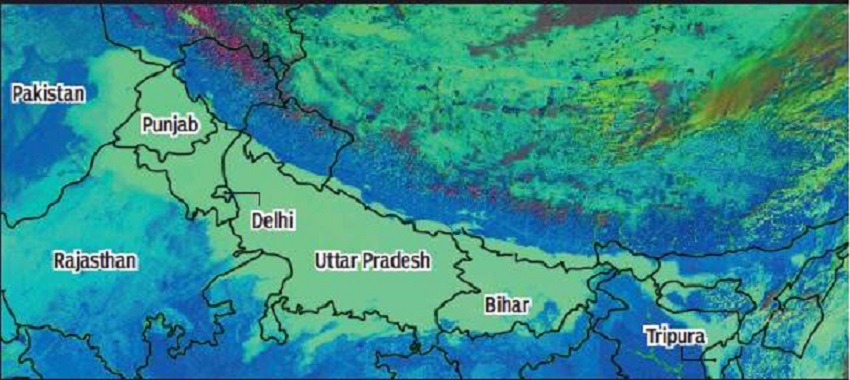
Insat 3D image shows unbroken fog (in pale green) from Pakistan to northeast India at 9.30am on Wednesday
From The Times of India
At 9.30am on 3 Jan 2018, an unbroken layer of fog was spread across more than 2,000km of the Indian subcontinent — starting from central Pakistan in the west, running right through the Indo-Gangetic plains and ending around Tripura.
Experts said, in terms of territory covered, it was one of the largest simultaneously formed, single fog episodes over any land area in the world.
The daytime multi-channel fog detection scheme image captured by Insat 3D shows the fog covering at least four countries — Pakistan, India, Nepal and Bangladesh. The fog actually began on Christmas Day in east UP and Bihar.
15 airports reported fog on Wednesday morning
The only comparable fog episode of this scale will have been from this region itself in previous years. Wednesday’s spread was certainly larger than other fog episodes in places such as central China, Italy or the California valley,” said R K Jenamani, head of the Met office at Delhi’s IGI Airport.
“After covering east UP and Bihar on Christmas, it started covering more areas in its west, including Delhi, by December 31. By January 2, it had covered Punjab and was continuing to move west into Pakistan. It has severely affected aviation, rail and road transport, and caused a sharp drop in day temperatures across the region,” Jenamani said.
Ironically, however, although the fog reached its maximum spread at 9.30am on Wednesday, visibility at many places in north India, including in Delhi-NCR, was in fact better at that time than in the previous two days. “The satellite picture shows the extent of the fog. What it doesn’t show is that at many places, the fog wasn’t actually on the surface but a few hundred metres in the air, like a very low cloud. Technically, it’s still a fog,” said Jenamani.
According to the IMD website, at least 15 airports in the country reported moderate to severe fog between 6.30am and 9.30am on Wednesday. These include Agartala, Patna, Gaya, Guwahati, Gorakhpur, Allahabad, Agra, Lucknow, Varanasi, Rae Bareli, Chandigarh, Jammu, Ludhiana and Pantnagar. The worst hit was Amritsar, which had visibility below 100m for 18 hours, from 6.30pm on Tuesday till 12.30pm on Wednesday.
Delhi, however, had visibility of around 300m. The Met office said visibility would further improve over the next two-three days. Fog is formed when a cold, moist air current meets relatively warm air, leading to formation of fine water droplets.
Jammu & Kashmir
2018
Fog hits train, air service; 2 flights cancelled
Banihal maximum 16.5 degree C and minimum zero degree Celsius,
Batote maximum 13.2 deg C and minimum 2 degree C.
Bhaderwah maximum 12.6 deg C and minimum minus 0.1 degree C. Bhaderwah experienced snowfall in the higher reaches during last 24 hours.
Bhaderwah-Bani road also experienced heavy snowfall in the Chatergala Pass area.
Gulmarg recorded a low of minus 6.8 degree Celsius while the day temperature of the place was 1.8 degree Celsius, 0.2 degree Celsius above normal.
Jammu recorded season’s lowest temperature: 4.3 Deg C, which is about 3 degree below normal. Maximum 15.1 degree C
Kargil town recorded coldest night of the season: 20 degrees below the freezing point. The minimum temperature in Kargil town plummeted over 14 degrees from the previous night’s low of minus 6.1 degrees Celsius to settle at a low of minus 20.6 degrees Celsius. Kargil was the coldest recorded place in the State
Katra recorded a maximum temperature of 17 degree C and minimum 6.2 deg C,
Kokernag recorded minus 1.7 degree Celsius while the day temperature of the place settled at 8.6 degree Celsius, 3.0 degree Celsius above normal.
Kupwara recorded a low of minus 3.8 degree Celsius while the day temperature of the place was 8.6 degree Celsius, 3.0 degree Celsius above normal.
Leh town recorded a minimum temperature of minus 16.6 degrees Celsius last night down from minus 14.7 degrees the previous night. This was the lowest night temperature of the season last night in Leh as well.
Pahalgam recorded minus 6.1 degree Celsius while the day temperature of the place settled at 8.0 degree Celsius, 3.2 degree Celsius above normal.
Qazigund recorded minus 4.0 degree Celsius last night while the day temperature settled at 10.0 degree Celsius, 2.9 degree Celsius above normal.
Srinagar recorded minus 4.1 degree Celsius temperature last night while the day temperature settled at 10.7 degree Celsius, 3.8 degree Celsius above normal.
A senior official at Jammu Airport said that due to dense fog in parts of Jammu and the northern region, two flights of Indo Airways and Air India were cancelled today while most of the flights were delayed. The first Indigo flight could land only at around 1.20 pm today at Jammu Airport. All other flights operated thereafter. He said not only in Jammu, the dense fog in Delhi and other parts of northern region delayed the operation of flights. The train services were also badly delayed in the region due to poor visibility and foggy weather conditions. A Northern Railways spokesman said that Indore- Jammu Express was delayed by three hours, Kolkata- Katra by two hours, Shiv Shakti by two hours, Hemkund Express also by two hours, Bathinda-Jammu Express by 6 hours, Sialdah Express by 7 hrs, Kathgodam Garibrath by 7 hours, Jhelum Express by 10 hours, Archana Express by 7 hours, Ahmedabad-Udhampur Express by 18 hours, Tata Moorie by 17 hours, Jamnagar-Jammu by 10 hours, Malwa Express by 6 hours while other trains by one to two hours.
The inter-state bus service in the region has also been affected badly due foggy weather conditions.
4th January
5th January
Munnar, Kerala/ minus 3°C, frost; ‘snowfall' in Kannimala/ 2019
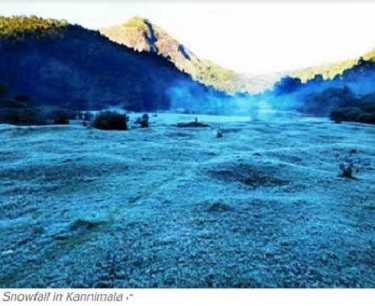
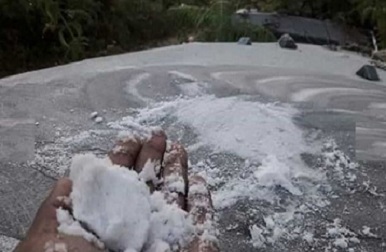
From The Times of India
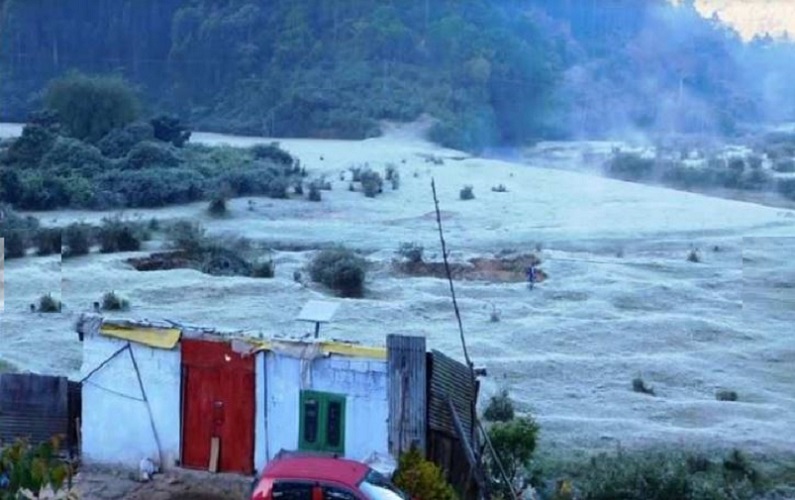
From The Times of India
KOCHI: Parts of popular hill station Munnar witnessed sub-zero temperatures with Chendura, Chittuvara and Lakkad recording minus 3 degrees Celsius on 5th Jan.
Thick layers of frost and fog turned the grassland areas into a white carpet across the entire land.
The meteorological department said that dry weather prevailed with minimum temperatures falling well below normal in Malappuram and Kollam districts. Idukki, Wayanad, Alappuzha, Kannur, Ernakulam and Thiruvananthapuram districts recorded fall in minimum temperatures on 6th Jan.
On 5 and 6 Jan, temperatures in Munnar town, Gudarvila, Nallathanni, Kannimala, Lakshmi and Kundala touched as low as minus 1 degree Celsius. Grasslands and plantations wore a snowy look as frost carpeted the land in many places.
Farmers in Munnar said that the drop in minimum temperatures would impact the crops, especially in the budding season as plants are very stressed out, trying to beat the frost in the night.
6th January
7th January
Munnar/ minus 4°C, 2019
The cold wave continued to grip Kerala with the season’s lowest temperature of minus four (-4) degree Celsius being recorded at Chenduvarai near Munnar.
8th January
9th January
10th January
11th January
12th January
13th January
14th January
15th January
16th January
17th January
18th January
19th January
20th January
21st January
22nd January
23rd January
24th January
25th January
26th January
27th January
28th January
29th January
30th January
31st January
See also
January weather in India <> February weather in India <> March weather in India <> April weather in India <> May weather in India <> June weather in India <> July weather in India <> August weather in India <> September weather in India <> October weather in India <> November weather in India <> December weather in India
